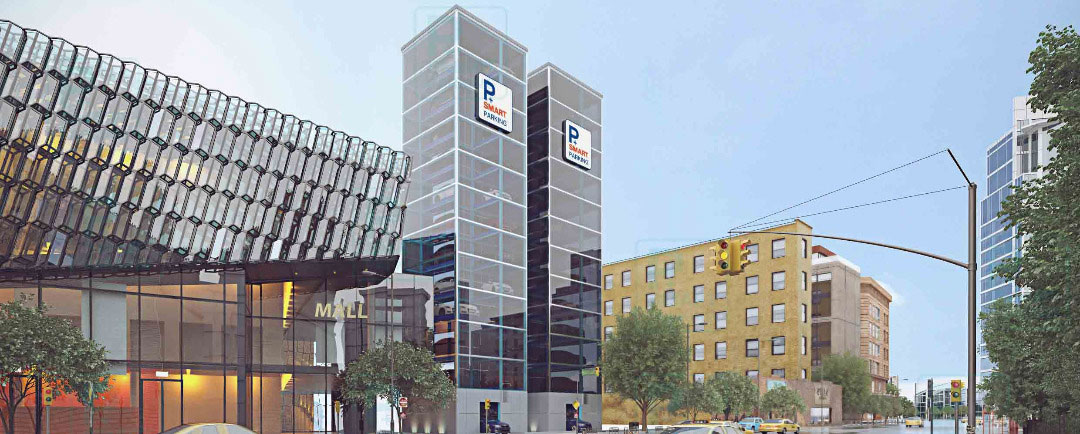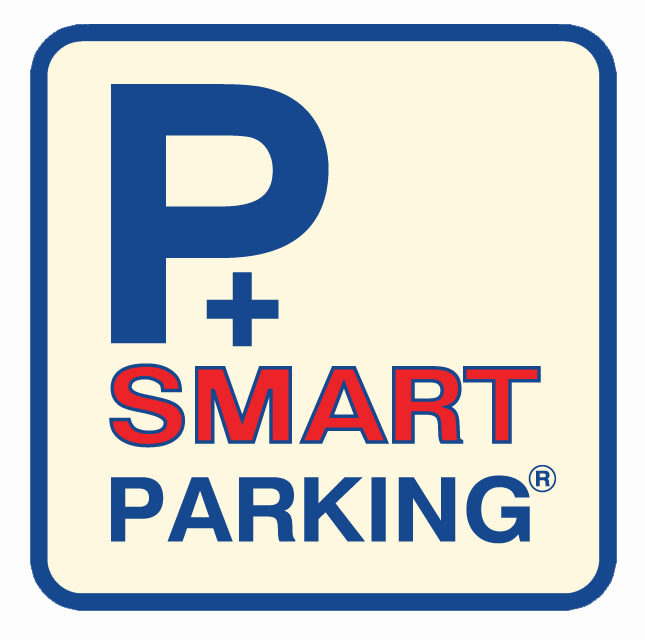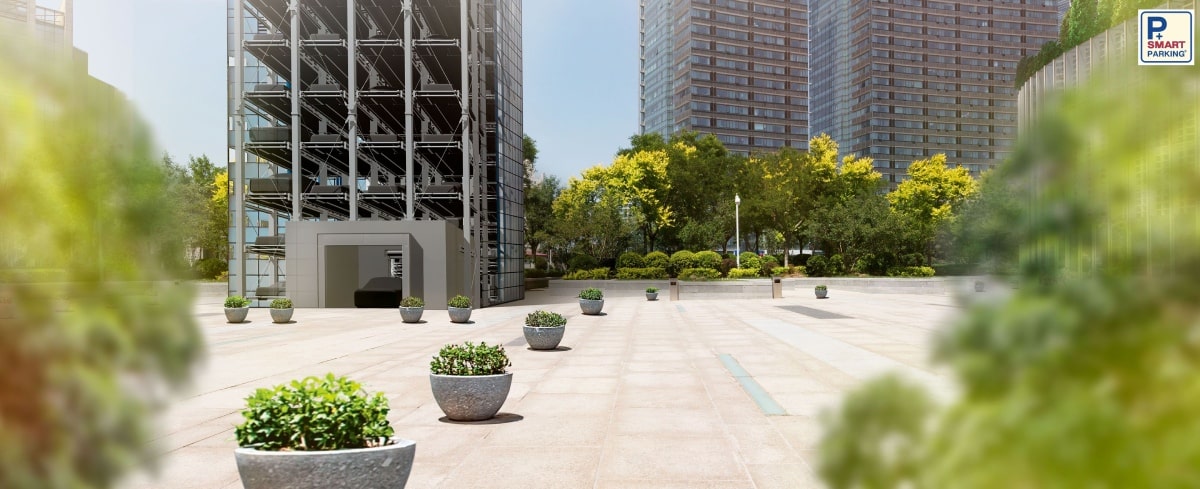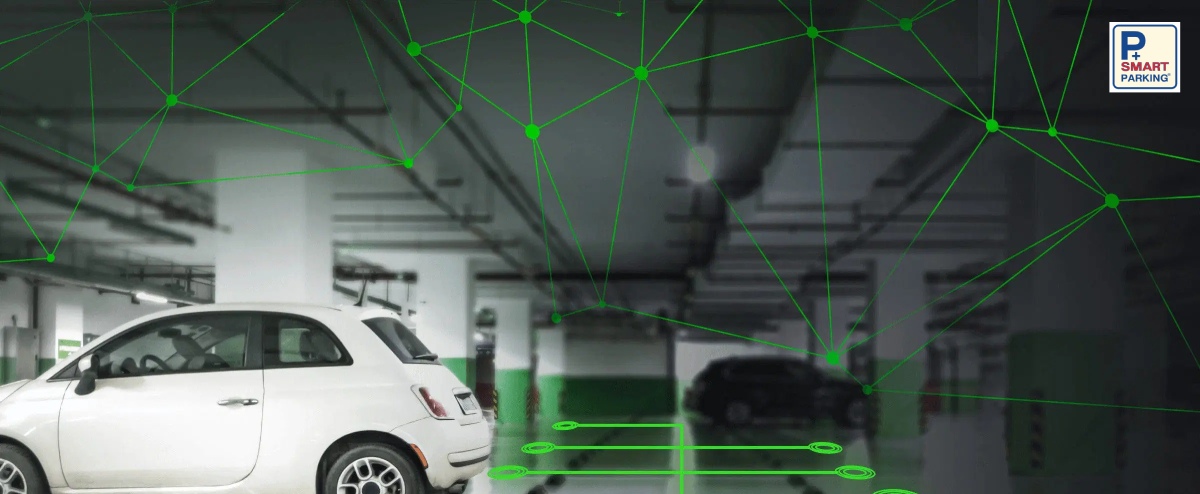
CE parking (tower or PCS)An automated multi-floor tower system for parking from 18 to 60 cars. This system is always the right choice if little floor space is available. Instead of expanding in width, the tower systems moves upward or downward – your vehicle is moved via elevator to a free parking space, where it is safely parked.The system is designed to move the vehicles on a pallet automatically and vertically on the elevator, it then transfers it horizontally left or right for storage.It may be integrated into an existing building or designed as a freestanding tower.
It is possible to design as Lower, midlevel or upper entrance system and install an underground, ground- level or underground and ground-level parking. A revolving platform is used in conditions of limited maneuvering space at the entrance to and exit from a transfer station, which facilitates the use of the parking. The system carries out the entire process of parking automatically and makes it possible for a driver to leave his/her safely inside.
Advantage:
- Vehicles are transported vertically by means of a lift mounted on steel lines and horizontally by means of chain transmission
- short time of waiting for a vehicle – from several seconds to 2 minutes
- Ideal to maximize parking in narrow plots.
- Easy maintenance and reliable operation
- Execution of positive and negative floors
- Max. height: 60 m
Safety:
۱٫ Input/output traffic lights
۲٫ Safety sensors
۳٫ Emergency stop switch
۴٫ Palette sensors
۵٫ Cable tear sensor
۶٫ Obstacles sensors (parking will be stopped)
۷٫ Fire sensors (optional)
As urban populations continue to grow and space becomes increasingly precious, innovative parking solutions have become essential for modern city development. Tower parking systems and also Automated Parking represent one of the most efficient and technologically advanced approaches to addressing urban parking challenges. These vertical parking structures combine sophisticated engineering with smart automation to maximize parking capacity while minimizing ground footprint. This comprehensive guide explores the various aspects of tower parking systems, from their fundamental operation to their impact on urban development and future prospects.
Understanding Tower Parking Technology
Tower parking systems represent a revolutionary approach to vertical parking solutions, utilizing advanced automation and mechanical systems to store vehicles in a tower-like structure. These systems operate on a simple yet ingenious principle: vehicles are transported vertically through a central lift mechanism and stored on multiple levels within a compact tower structure. Unlike conventional multi-story parking garages, tower parking systems eliminate the need for internal ramps, driving lanes, and large maneuvering spaces. The technology incorporates sophisticated sensors, positioning systems, and control mechanisms to ensure precise vehicle placement and retrieval. Modern tower parking systems can accommodate various vehicle sizes and weights, with some systems capable of storing vehicles up to large SUVs and light commercial vehicles. The automation process significantly reduces the time required for parking and retrieval while eliminating the risk of human error in vehicle handling. These systems often feature advanced user interfaces, including touchscreen controls and mobile app integration, making them highly accessible and user-friendly.
Mechanical Engineering and Structural Design
The engineering principles behind tower parking systems showcase the perfect integration of structural design and mechanical innovation. The core structure consists of a robust steel framework designed to withstand both static and dynamic loads while maintaining stability at significant heights. The central lifting mechanism, typically a high-capacity elevator system, incorporates precision-engineered components including heavy-duty motors, cables or chains, and sophisticated braking systems. Load-bearing calculations must account for various factors including vehicle weights, dynamic forces during lift operations, wind loads, and seismic considerations. The structural design incorporates multiple safety features, including mechanical locks, emergency braking systems, and backup power supplies. Special attention is paid to the foundation design, which must support the entire structure and accommodate local soil conditions. The system’s modular design allows for future expansion or modification while maintaining operational efficiency. Advanced materials and coating technologies protect against environmental factors and extend the system’s operational lifespan.
Space Optimization and Urban Integration
Tower parking systems excel in maximizing parking capacity within a minimal footprint, making them ideal for urban environments where space is at a premium. These systems can typically accommodate 10-15 vehicles in the same ground space required for two conventional parking spots. The vertical design allows property developers to significantly increase parking capacity without expanding horizontal footprint. The compact nature of these systems enables their integration into various urban settings, including existing buildings, narrow lots, and challenging site conditions. Urban planners and architects can incorporate tower parking systems into mixed-use developments, creating seamless integrations that enhance rather than detract from the urban landscape. The reduced footprint allows for the preservation of valuable urban space for other uses, such as green areas, pedestrian zones, or additional commercial space. The flexibility in design enables these systems to be adapted to various architectural styles and urban contexts, ensuring they complement the surrounding cityscape.
Smart Control Systems and Automation
Modern tower parking systems leverage advanced control systems and automation technologies to ensure efficient and reliable operation. The heart of these systems lies in sophisticated software that manages vehicle movement, coordinates storage and retrieval operations, and optimizes space utilization. Advanced sensors continuously monitor system status, vehicle positioning, and mechanical operations to prevent errors and ensure safety. Integration with mobile applications allows users to reserve parking spaces, track their vehicles, and initiate retrieval processes remotely. The control system incorporates artificial intelligence and machine learning algorithms to analyze usage patterns and optimize operational efficiency. Advanced security features include access control, vehicle identification, and surveillance systems. The automation extends to maintenance monitoring, with predictive analytics helping to identify potential issues before they affect system performance. Emergency protocols are built into the control system, ensuring safe operation even during power outages or system anomalies.
Environmental Impact and Sustainability
Tower parking systems contribute significantly to environmental sustainability through various mechanisms. The vertical design requires less ground space compared to traditional parking structures, helping preserve urban green spaces and reduce the heat island effect. The automated nature of these systems eliminates vehicle emissions typically associated with searching for parking spaces or idling in conventional garages. Energy-efficient motors and smart power management systems optimize electricity consumption during operation. Some advanced systems incorporate renewable energy sources, such as solar panels, to offset operational energy requirements. The reduced construction footprint minimizes environmental impact during installation and requires fewer materials compared to traditional parking structures. These systems can be equipped with electric vehicle charging capabilities, supporting the transition to sustainable transportation. The elimination of traditional ventilation requirements and reduced lighting needs further decrease the overall environmental impact. The durability and longevity of these systems also contribute to sustainability by reducing the need for frequent replacements or major renovations.
Cost Analysis and Economic Benefits
While tower parking systems require significant initial investment, their long-term economic benefits often justify the cost. The primary financial advantage comes from maximizing parking capacity within a limited space, particularly valuable in areas with high real estate costs. Operational costs are generally lower due to automated operation, reduced staffing requirements, and efficient energy consumption. Maintenance costs, while requiring specialized expertise, are offset by the system’s ability to protect vehicles from damage and weather exposure. The automated operation enables flexible pricing models and premium services that can generate higher revenue per parking space. Property developers often report increased property values and rental rates for buildings equipped with tower parking systems. The space efficiency allows for additional revenue-generating areas within the same property footprint. Insurance costs may be reduced due to enhanced security features and lower accident risks compared to traditional parking facilities.
Safety Features and Security Protocols
Safety and security are paramount in the design and operation of tower parking systems. Multiple layers of safety features protect both vehicles and users during parking and retrieval operations. Advanced sensors continuously monitor lift operations, vehicle placement, and system status to prevent mechanical failures or accidents. Emergency stop buttons are strategically placed throughout the facility, allowing immediate system shutdown if necessary. Access control systems ensure only authorized users can retrieve their vehicles, significantly reducing theft and vandalism risks. Fire safety features include integrated detection and suppression systems, often exceeding standard parking structure requirements. Security cameras and monitoring systems provide continuous surveillance of entry/exit points and operational areas. User safety is enhanced through well-lit waiting areas, clear instructions, and intuitive interfaces. Regular safety audits and maintenance checks ensure all security features remain fully functional and compliant with current safety standards.
Future Trends and Technological Innovation
The future of tower parking systems is closely tied to advancing technology and changing urban mobility patterns. Integration with smart city infrastructure enables real-time parking availability updates and dynamic pricing based on demand. Artificial intelligence and machine learning algorithms continue to improve operational efficiency and user experience. Development of autonomous vehicle compatibility allows for seamless integration with self-parking cars. Advanced materials and manufacturing techniques promise more durable and efficient system components. Internet of Things (IoT) integration enables better system monitoring and predictive maintenance capabilities. Mobile technology advancements improve user interface and remote system access. Virtual and augmented reality applications assist in maintenance training and system diagnostics. Blockchain technology may be implemented for secure payment processing and access control. The continued evolution of electric vehicles drives the integration of charging capabilities within tower parking systems.
Tower Parking Systems: A Complete Guide to Vertical Parking Solutions
Tower parking systems represent a significant advancement in addressing urban parking challenges through innovative technology and efficient design. As cities continue to grow and evolve, these systems will play an increasingly important role in managing vehicle storage while optimizing space utilization. The combination of space efficiency, environmental benefits, and technological integration makes tower parking systems a compelling solution for modern urban development. Property developers, urban planners, and city administrators should carefully consider implementing these systems as part of their long-term development strategies, recognizing both the immediate benefits and future potential of these innovative parking solutions. The continued advancement of technology and increasing emphasis on sustainable urban development will likely drive further improvements and wider adoption of tower parking systems in the coming years.
| Product Name | ACE PARKING® | ||
|---|---|---|---|
| Model | AC20L ~ AC60L | AC20SU ~ AC50SU | |
| Capacity | ۲۰ to 60 cars | ۲۰ to 50 cars | |
| Ava. car | |||
| Length | ۵,۲۰۰mm | ۵,۲۰۰mm | |
| Width | ۲,۱۰۰mm | ۲,۱۰۰mm | |
| Height | ۱,۶۰۰mm | ۲,۰۰۰mm | |
| Weight | ۲,۱۵۰kg | ۲,۴۰۰kg | |
| Type of car | Sedan | SUV | |
| Lifting Mechanism | Geared Motor + Wire Rope | ||
| Lift Motor | ۲۲kW ~ 37kW | ||
| Lift Speed | ۹۰m/min Max. | ||
| Car retrieving time | ۱۰۰ – ۱۴۰ sec. | ||
| Motor Control | IGBT Inverter control | ||


